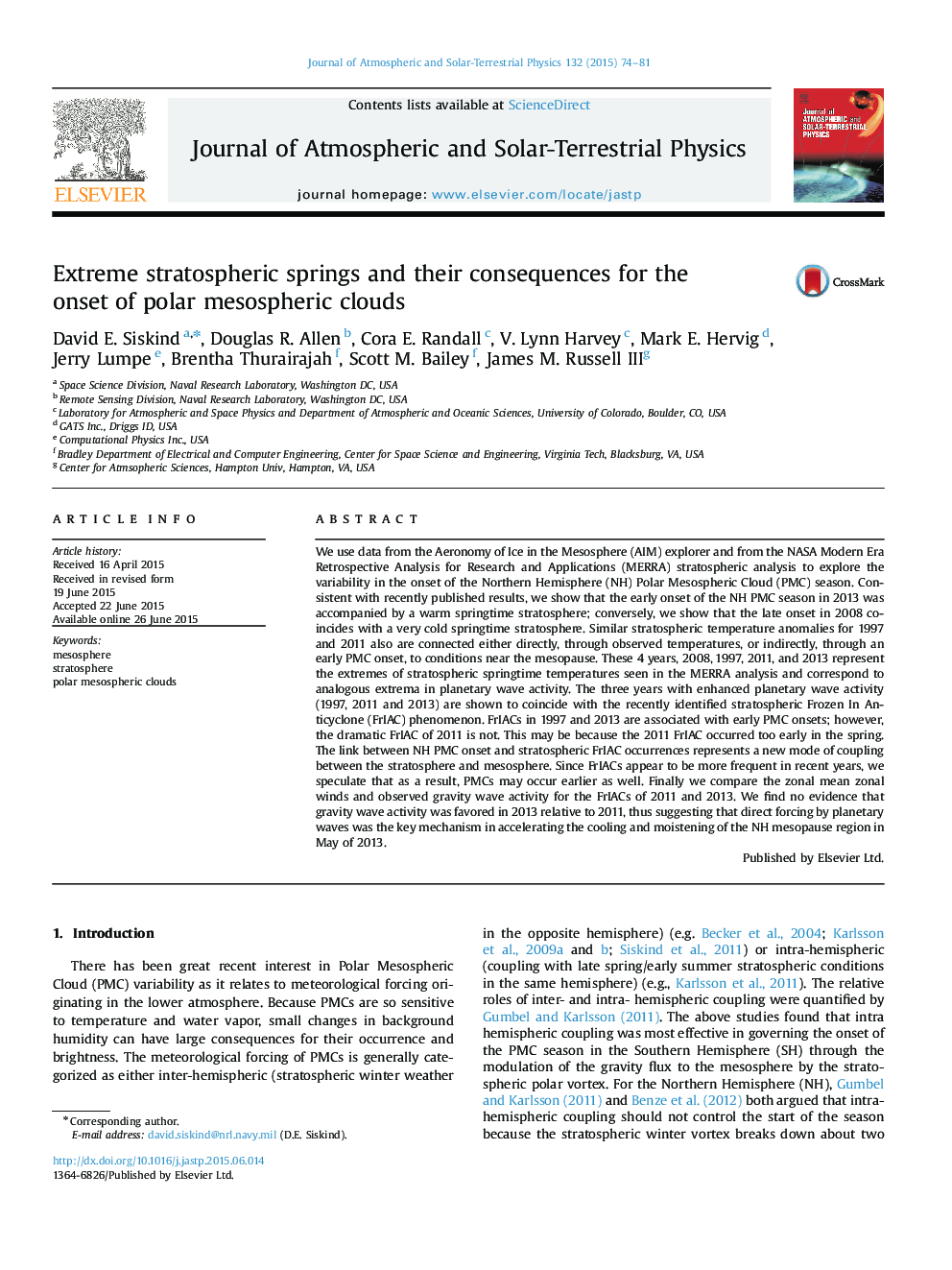| کد مقاله | کد نشریه | سال انتشار | مقاله انگلیسی | نسخه تمام متن |
|---|---|---|---|---|
| 1776381 | 1523612 | 2015 | 8 صفحه PDF | دانلود رایگان |
عنوان انگلیسی مقاله ISI
Extreme stratospheric springs and their consequences for the onset of polar mesospheric clouds
ترجمه فارسی عنوان
چشمه های استراتوسفر شدید و عواقب آن برای شروع ابرهای مزوسفر قطبی
دانلود مقاله + سفارش ترجمه
دانلود مقاله ISI انگلیسی
رایگان برای ایرانیان
کلمات کلیدی
مزوسفر، استراتوسفر، ابرهای مزوسفر قطبی،
موضوعات مرتبط
مهندسی و علوم پایه
علوم زمین و سیارات
فیزیک زمین (ژئو فیزیک)
چکیده انگلیسی
We use data from the Aeronomy of Ice in the Mesosphere (AIM) explorer and from the NASA Modern Era Retrospective Analysis for Research and Applications (MERRA) stratospheric analysis to explore the variability in the onset of the Northern Hemisphere (NH) Polar Mesospheric Cloud (PMC) season. Consistent with recently published results, we show that the early onset of the NH PMC season in 2013 was accompanied by a warm springtime stratosphere; conversely, we show that the late onset in 2008 coincides with a very cold springtime stratosphere. Similar stratospheric temperature anomalies for 1997 and 2011 also are connected either directly, through observed temperatures, or indirectly, through an early PMC onset, to conditions near the mesopause. These 4 years, 2008, 1997, 2011, and 2013 represent the extremes of stratospheric springtime temperatures seen in the MERRA analysis and correspond to analogous extrema in planetary wave activity. The three years with enhanced planetary wave activity (1997, 2011 and 2013) are shown to coincide with the recently identified stratospheric Frozen In Anticyclone (FrIAC) phenomenon. FrIACs in 1997 and 2013 are associated with early PMC onsets; however, the dramatic FrIAC of 2011 is not. This may be because the 2011 FrIAC occurred too early in the spring. The link between NH PMC onset and stratospheric FrIAC occurrences represents a new mode of coupling between the stratosphere and mesosphere. Since FrIACs appear to be more frequent in recent years, we speculate that as a result, PMCs may occur earlier as well. Finally we compare the zonal mean zonal winds and observed gravity wave activity for the FrIACs of 2011 and 2013. We find no evidence that gravity wave activity was favored in 2013 relative to 2011, thus suggesting that direct forcing by planetary waves was the key mechanism in accelerating the cooling and moistening of the NH mesopause region in May of 2013.
ناشر
Database: Elsevier - ScienceDirect (ساینس دایرکت)
Journal: Journal of Atmospheric and Solar-Terrestrial Physics - Volume 132, September 2015, Pages 74-81
Journal: Journal of Atmospheric and Solar-Terrestrial Physics - Volume 132, September 2015, Pages 74-81
نویسندگان
David E. Siskind, Douglas R. Allen, Cora E. Randall, V. Lynn Harvey, Mark E. Hervig, Jerry Lumpe, Brentha Thurairajah, Scott M. Bailey, James M. III,
